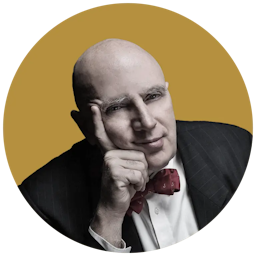Supporting the Big Band Theory
This article is from the archive of The New York Sun before the launch of its new website in 2022. The Sun has neither altered nor updated such articles but will seek to correct any errors, mis-categorizations or other problems introduced during transfer.

Anyone who grew up reading comic books — and this is something to think about as you’re waiting in line to see “Transformers” this weekend — is familiar with the concept of alternate pasts and futures. Imagine, for instance, that 60 years ago, at the end of World War II, General Patton marched into Moscow and put Stalin out of business. Then picture the second half of the 20th century without the Cold War.
Big Bands are like that: Imagine a world in which large-format orchestral jazz was not displaced by economics or changing modes of taste, where people still danced and listened to music by brilliant composer-orchestrators, with ingenious improvising soloists to further drive the message home. In a perfect world, big bands would flourish side by side with such later developments as bebop and rock; in fact, they would incorporate the best aspects of other musics into the big band sensibility.
The music of trombonist John Fedchock, whose “New York Big Band” played at the Blue Note on Monday to celebrate the release of its fourth album , “Up and Running” (Reservoir Music), is also like that. Mr. Fedchock and most of his musicians are in their 50s; 25 years ago they were part of the final generation of musicians to work with the longest-lasting veterans of the swing era, such as Count Basie and Woody Herman. Both Mr. Fedchock and his drummer Dave Ratajczak were part of the last of the Herman Herds.
Mr. Fedchock’s current music sounds like what I imagine Herman would be playing if he lived into the millennium. It’s driven by the same values as Benny Goodman and Duke Ellington — swinging danceable rhythms, themes and variations, and call-and-response — but there also are contemporary harmonies and up-to-date beats that were unknown in Herman’s heyday. This is big band music that’s as much inspired by John Coltrane as Louis Armstrong. In fact, the new album contains three Trane-specific tunes, among them the leader’s original “Elvin’s Empire,” dedicated to drummer Elvin Jones and the swirling energy he brought to Coltrane’s Classic Quartet.
Fred Lacey’s classic ballad “Theme for Ernie” is played more or less the same way as Coltrane played it on the classic “Soultrane” album, here featuring the tenor saxist Rich Perry, supported by a full horn contingent and Mr. Fedchock’s opulent colorations, rather than simply a trio. Contrastingly, Coltrane’s own “Moment’s Notice” is a thing apart from the way the composer recorded it on “Blue Train”; Mr. Fedchock has boldly reworked it into what he calls a “Latin extravaganza.” Mr. Fedchock did more than put a salsa beat and montunos behind Coltrane’s Tadd Dameron-esque melody, but rather, completely reworked the piece to the point where I wouldn’t have recognized it.
Mr. Fedchock began the Monday set with the album’s title track, “Up and Running,” a hard-driving, almost antagonistic piece, that here featured the exceptional alto sax soloist Steve Wilson (who, alas, is not on the album, although Mark Vinci, who is, is also first-rate). Later in the set, the band played “Blue After Two,” a slow chromatic blues that Mr. Fedchock described as his attempt to write a funky roadhouse kind of a tune. The most erotic part of the piece was pianist Allan Farnham’s warm piano solo, phrased in Red Garland-like chords. The brass sections were, like nearly everything the Fedchock band plays, more blasty and exciting than sensual. The most romantic arrangement was Mr. Fedchock’s reconstruction of Gershwin’s “Embraceable You,” which was also liberally rewritten, with unexpected extra beats in the main melody; the most notable feature of the chart was the use of flugelhorns instead of trumpet, which combined with the arranger’s mellow, open sonorities to suggest what Claude Thornhill would sound like 60 years after the fact.
The New York tradition of Monday night big bands, in which top-flight musicians work for a fraction of what they get in the studios, has long since spread to the West Coast. If ever there was a battle of bands between representatives of the two coasts, I would love to see Mr. Fedchock’s aggressive New York Big Band go against the hardly-laid-back Los Angelenos, led by pianist and saxophonist Gordon Goodwin, who has also just released a new album, “The Phat Pack” (immergent CD). In fact, Mr. Goodwin opens with a comparably (and topically) titled up-tempo called “Cut ‘n’ Run.”
“The Phat Pack” offers an even more flamboyant mixture of the jazz history, rendered with characteristic Hollywood-style extravagance — as indicated by the album artwork, which is done in the style of “Mad” magazine caricaturist Mort Drucker. Mr. Goodwin, who directs soundtracks for film and animation by day, includes a lot of cinematic references in his music, as on the noirish “Whodunnit” and a swinging update of his own work in the infamous B-movie “Attack of the Killer Tomatoes.” The Big Phat Band gets as retro as “Hunting Wabbits 2 (A Bad Hare Day),” an homage to Looney Tunesmiths Carl Stalling and Raymond Scott, and as contemporary as a thoroughly revamped update of the disco hit “Play That Funky Music” that spotlights smooth jazz sax star David Sanborn.
Mr. Goodwin’s skills as a musical mimic and prankster are a driving force of the album, but he also can get serious, as on the patriotic closer “Ever Braver, Ever Stronger,” with its overtones of Aaron Copland. “The Phat Pack” and “Count Bubba’s Revenge” are both essays in blues form, the first with Basie-style dynamics. Until now, I always thought that musicians moved to Hollywood and got jobs in the studios to get away from the blues. Shows you what I know.

